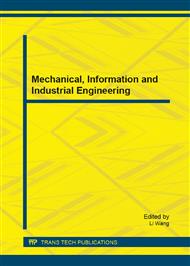p.91
p.95
p.99
p.104
p.108
p.112
p.116
p.120
p.127
Finite Element Analysis of the Car Steering Knuckle Based on ANSYS
Abstract:
Steering axle and steering knuckle arm often appear craze problem within its service life. In this paper, the structure of a car steering knuckle was investigated using finite element program at uneven road surface conditions, emergency braking condition and sideslip conditions under the condition of full load. The results show that the joint shaft neck and adjacent shoulder of steering knuckle are the easiest to be damaged. At the same time, the steering knuckle meets the strength requirement under various conditions. Secondly, use the theory of fatigue to analysis and consider parts material fatigue properties, mean stress and other factors. Steering knuckle fatigue simulations use the ANSYS software to estimate the fatigue life. Under the condition of loop 900000 times, there was no damage in steering knuckle. According to the analysis results, reduce stress concentration and the surface roughness for steering knuckle improvement measures are proposed
Info:
Periodical:
Pages:
108-111
Citation:
Online since:
March 2015
Authors:
Price:
Сopyright:
© 2015 Trans Tech Publications Ltd. All Rights Reserved
Share:
Citation:


